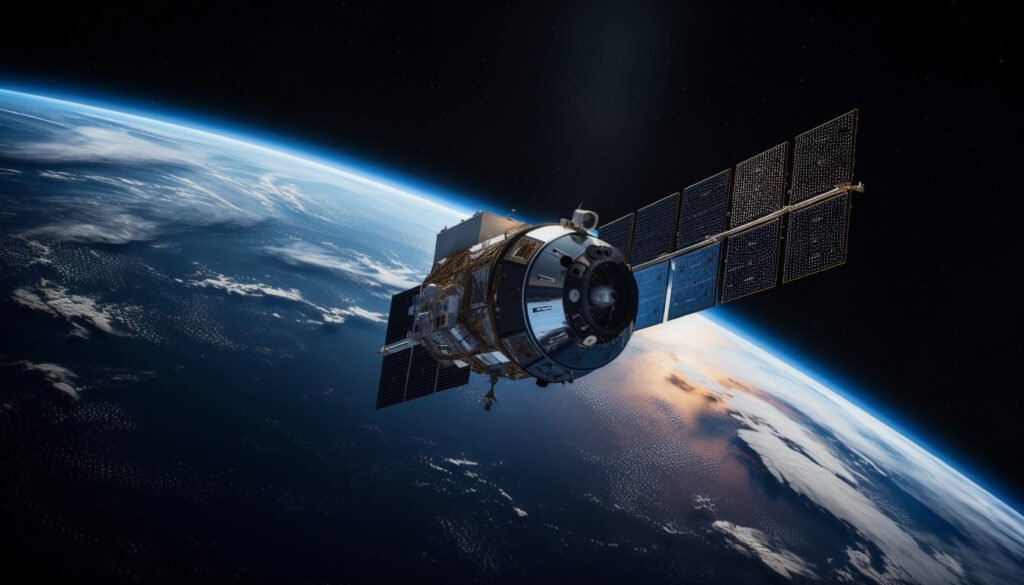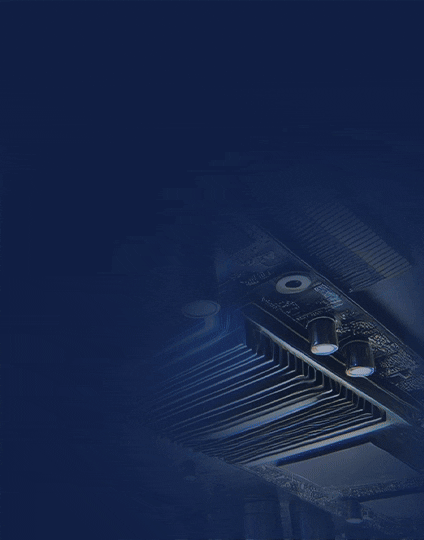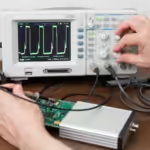Introduction:
At the forefront of human technological achievement, space exploration pushes the limits of our knowledge and capabilities. We need to use the best technology possible in our satellites and spacecraft as we travel farther into space. Field-Programmable Gate Arrays (FPGAs) are one of the innovations that is crucial to the operation of these space missions.
Because of their reconfigurability and adaptability, FPGAs have become indispensable parts that allow adaptive computing, data handling, and real-time processing in the harsh environment of space. This investigation explores the deep influence FPGAs have on space missions and emphasizes their importance in overcoming the difficulties brought on by the hostile environments beyond Earth.
Essentially, FPGAs are electronic devices with programmable logic components that make digital circuit design and implementation more flexible. This adaptability becomes a valuable asset in space exploration, meeting the missions’ changing and dynamic needs.
FPGAs can be reconfigured on the fly, which makes them perfect for applications where mission parameters may change during the mission, unlike traditional Application-Specific Integrated Circuits (ASICs). The next generation of spaceborne technologies will be powered by FPGAs because of their versatility and capacity to handle challenging processing tasks.
The need for effective data processing, quick decision-making, and resilience to the hostile environment of space highlight the need for cutting-edge technology in space exploration. In addition to satisfying these requirements, FPGAs help achieve the power efficiency required for prolonged missions.
The upcoming investigation will reveal the complex function of FPGAs in powering satellites and spacecraft, demonstrating their revolutionary influence on the field of space technology, as we traverse the difficulties of space travel, including radiation exposure and extremely high temperatures.
Role of FPGAs in Space Applications
FPGAs are essential to space applications because they offer flexible and adaptive solutions to the particular problems encountered in the harsh environment of space. They are ideal for a range of applications on satellites and spacecraft due to their reconfigurable nature and capacity to implement intricate digital circuits.
Here, we explore particular space application domains where FPGAs excel:
A. Onboard Processing and Data Handling:
- Real-time Data Processing: Satellites and spacecraft can handle massive volumes of data in real-time thanks to the use of FPGAs for on-the-fly data processing. For missions like Earth observation and remote sensing, which have strict latency requirements, this is especially helpful.
- Adaptive Computing: Adaptive computing architectures, made possible by FPGAs, enable spacecraft to dynamically modify their processing power according to mission phase. The ability to adapt is crucial for managing a variety of responsibilities, such as scientific data analysis and communication as well as navigation.
- Customized Algorithms: FPGAs can be programmed to implement custom algorithms tailored to the specific needs of a mission. This capability is invaluable for scientific missions where data processing requirements may vary widely.
B. Real-time Signal Processing for Scientific Instruments:
- Instrument Control: FPGAs ensure accurate operation and synchronization by controlling and interacting with scientific instruments. For experiments involving imaging, spectroscopy, and other scientific measurements, this is essential.
- Signal Conditioning: FPGAs perform real-time signal conditioning, enhancing the quality of scientific data collected from sensors and instruments. This capability is particularly beneficial in space missions where sensor data may be subject to noise and interference.
- Image and Signal Compression: FPGAs contribute to the efficient compression of images and signals, enabling the transmission of valuable scientific data back to Earth within the limited bandwidth available in space communications.
C. Adaptive Computing in Response to Changing Mission Requirements:
- Mission Flexibility: Spacecraft can adjust to unforeseen changes in mission requirements thanks to FPGAs’ on-the-fly hardware reconfiguration capabilities. This is important for missions that might experience unexpected obstacles or see their objectives change.
- Software-defined Systems: Software-defined systems are implemented with the help of FPGAs, allowing for remote updates and modifications. As a result, fewer physical interventions are required, which facilitates problem-solving and performance optimization over the course of the mission.
- Multi-Functionality: FPGAs contribute to multi-functionality by enabling the implementation of diverse processing tasks on a single chip. This integration reduces the overall complexity of the spacecraft’s electronics while enhancing its capabilities.
Power Efficiency in Space
Space missions require close attention to power efficiency, whether they are traveling around Earth, to other planets, or deep into our solar system. Space has limited energy resources, so technologies that optimize functionality while reducing power consumption are required.
Within this framework, Field-Programmable Gate Arrays, or FPGAs, have become essential elements for striking the fine balance between processing power and energy efficiency.
A. Importance of Power Efficiency in Space
- Resource Constraints: Solar panels or radioisotope thermoelectric generators (RTGs), which have a limited supply of energy, are frequently used to power spacecraft. Effective use of this energy is essential to a space mission’s longevity and success.
- Weight Considerations: Every additional kilogram of weight in a spacecraft requires more fuel for propulsion. Minimizing power consumption directly contributes to reducing the overall weight of the spacecraft, enabling more efficient launches and extending mission lifetimes.
B. Contribution of FPGAs to Power Optimization
- Dynamic Reconfigurability: One feature that sets FPGAs apart is their reconfigurability, which enables real-time hardware architecture modifications. With the help of this capability, processing elements that are specifically designed for a given task can be deployed, reducing the needless power consumption that comes with fixed hardware.
- Parallel Processing: FPGAs excel at parallel processing, executing multiple tasks simultaneously. This parallelism not only accelerates computations but also enables the rapid completion of tasks, allowing the FPGA to return to a low-power state sooner.
- Adaptive Computing: FPGAs can adapt their configuration to match the computational requirements of different mission phases. During periods of low activity, the FPGA can operate in a low-power state, conserving energy until more intensive processing is required.
C. Examples of Power-Efficient FPGA Implementations in Space Missions
- Data Compression: FPGAs can be employed for real-time data compression, reducing the amount of information that needs to be transmitted back to Earth. This not only conserves communication bandwidth but also minimizes the power required for data transmission.
- Image Processing: Space missions often involve capturing and analyzing images. FPGAs can handle image processing tasks efficiently, facilitating the extraction of valuable information while consuming minimal power.
- Navigation and Control: FPGAs play a crucial role in spacecraft navigation and control systems. Their ability to quickly process sensor data and execute control algorithms in real-time contributes to efficient trajectory adjustments and orientation control.
Radiation Hardening Techniques
Radiation is a persistent threat to electronic components, including FPGAs, in the harsh environment of space. Solar radiation and cosmic rays can cause defects and mistakes in semiconductor devices, which could jeopardize space systems’ ability to operate. Radiation hardening techniques are used to ensure the resilience and dependability of FPGAs in space applications in order to address these challenges.
A. Challenges of Radiation in Space Environments
Radiation in many forms, such as solar wind, electromagnetic radiation, and high-energy particles, is present in space. Single-event effects (SEEs) like single-event upsets (SEUs), single-event latch-ups (SELs), and single-event transients (SETs) can be brought on by these radiations. SEEs have the potential to permanently harm electronic components, corrupt data, and interfere with regular operations.
Since FPGAs are the brains behind a lot of space systems, they have to be resilient to these kinds of things in order to make space missions successful.
B. Techniques for Hardening FPGAs Against Radiation
- Triple Modular Redundancy (TMR): TMR is a widely used method to improve FPGA reliability. This method involves three identical circuits running in parallel, with a voting mechanism controlling the output. The other two circuits can outvote one circuit in the event of a radiation-induced error, guaranteeing the correct output.
- Configuration Memory Scrubbing: Radiation-induced errors can affect the memory cells used by FPGAs to store their configuration. In order to guarantee that the FPGA is always configured correctly, configuration memory scrubbing entails routinely reading and fixing errors in the configuration memory.
- Latch-Up Prevention: When a high-energy particle activates the parasitic thyristor structure inside the FPGA, a short circuit results, leading to radiation-induced latch-ups. Design strategies are used to stop latch-up events and safeguard the FPGA, such as guard rings and specific layouts.
- Radiation-Hardened-by-Design (RHBD): RHBD involves designing FPGAs with radiation resilience from the ground up. By employing specific design practices, materials, and manufacturing processes, FPGAs can be inherently more resistant to radiation effects.
C. Case Studies of Successful Radiation-Hardened FPGA Designs
- Xilinx Space-Grade FPGAs: Xilinx, a leading FPGA manufacturer, offers space-grade FPGAs with enhanced radiation tolerance. These FPGAs undergo rigorous testing and use radiation-hardened materials to withstand the harsh conditions of space.
- Actel ProASIC3: The Actel ProASIC3 family of FPGAs incorporates Flash*Freeze technology, providing immunity to radiation-induced configuration upsets. This technology ensures the FPGA remains operational in the presence of radiation.
- Microsemi RTG4: Microsemi’s RTG4 FPGAs are designed for space applications, featuring radiation-hardened design techniques and capabilities to mitigate the effects of radiation. These FPGAs are suitable for use in critical space missions.
Case Studies
Modern technologies have enabled incredible advancements in space exploration, and FPGAs have been essential in boosting satellite and spacecraft capabilities. A closer look at individual case studies reveals how FPGAs have been used in different space missions, helping to make those missions successful and further our understanding of the universe.
Mars Rovers:
a. Curiosity Rover (Mars Science Laboratory):
- FPGAs employed for real-time control and processing of scientific data.
- Adaptive computing capabilities used to adjust operations based on environmental conditions.
- Examples of FPGA-driven autonomy in navigation and hazard avoidance.
b. Opportunity and Spirit Rovers:
- FPGAs utilized for image processing and terrain analysis.
- Role of reconfigurable computing in adapting to unanticipated challenges.
- Longevity and reliability enhancements achieved through FPGA-based systems.
Earth Observation Satellites:
a. Sentinel-1 and Sentinel-2 (European Space Agency):
- FPGAs used for on-board processing of synthetic aperture radar (SAR) data.
- Real-time image analysis and data compression techniques.
- Power-efficient FPGA implementations for extended mission life.
b. Landsat Program (NASA/USGS):
- FPGAs applied in sensor data processing for land imaging.
- Role in enhancing data accuracy and reducing transmission bandwidth.
- Integration with other technologies for comprehensive Earth observation.
Deep Space Probes:
a. Voyager 1 and 2 (NASA):
- FPGAs incorporated for data compression and transmission.
- Challenges of long-duration missions addressed through reprogrammability.
- Radiation-hardened FPGAs contributing to resilience in deep space.
b. New Horizons (NASA):
- FPGAs employed for real-time data analysis during the Pluto flyby.
- Adaptive computing enabling quick adjustments to unexpected discoveries.
- Achievements and challenges in utilizing FPGAs for distant exploration.
These case studies underscore the versatility of FPGAs in different space missions, showcasing their adaptability, reconfigurability, and crucial role in addressing the challenges posed by the harsh space environment. The success of these missions highlights the importance of FPGAs in advancing our capabilities to explore and understand the universe.
Conclusion:
In summary, a new era of technological advancement has been brought about by the integration of Field-Programmable Gate Arrays (FPGAs) in space exploration, which has improved the capabilities of satellites and spacecraft. FPGAs’ reconfigurable nature, along with their versatility and adaptability, have proven to be crucial in helping to overcome the difficulties presented by the harsh and demanding conditions found in space.
FPGAs are essential to space missions because they enable onboard processing and data handling with previously unheard-of levels of efficiency. Their ability to process signals in real time allows scientific instruments to analyze and send important data, leading to a better understanding of the universe and its phenomena. Additionally, the adaptable platform that FPGAs’ adaptive computing capabilities offer allows for customization to meet changing mission requirements, guaranteeing that space exploration.
The effect of radiation on electronic components is one of the main obstacles in space exploration. FPGAs have proven resilient in the face of these difficulties because they were designed using radiation-hardening techniques. Through the use of cutting-edge techniques to lessen the effects of radiation, FPGAs have demonstrated their robustness and dependability in a number of space missions.
A crucial factor in the design of satellites and spacecraft is power efficiency. FPGAs have a major impact on power optimization and are essential in making sure that the power resources that are available are used effectively. This allows for the completion of increasingly complex tasks within the limitations of power budgets, in addition to prolonging the operational life of space missions.
At last, FPGAs have shown to be essential for powering satellites and spacecraft, spurring creativity, and facilitating advances in our understanding of the universe. FPGAs will play a more important role as we explore farther into the unknown, helping to ensure that space exploration keeps pushing the limits of human knowledge and capability. With the adaptability and durability of FPGAs enabling space travel, new discoveries and the answers to the universe’s mysteries could be revealed.


![What is FPGA Introduction to FPGA Basics [2023] computer-chip-dark-background-with-word-intel-it](https://fpgainsights.com/wp-content/uploads/2023/06/computer-chip-dark-background-with-word-intel-it-300x171.jpg)









